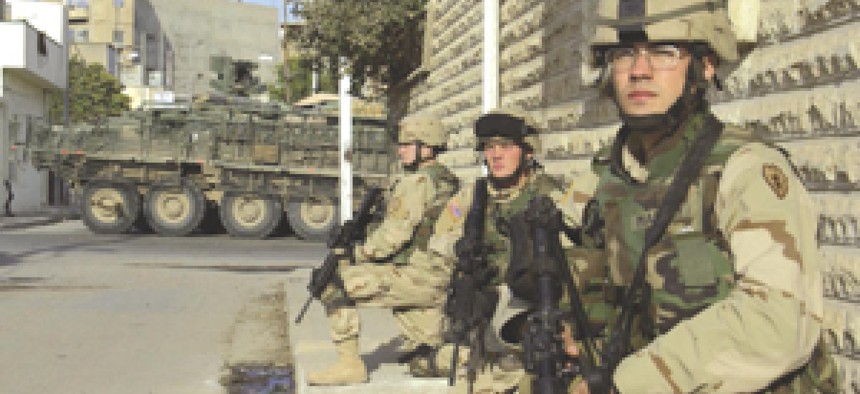New tools spur collaboration

When U.S. tanks rolled into Baghdad during the invasion of Iraq, one of the command vehicles was outfitted with cyclone antennas to establish a link with orbiting satellites. The satellite connection gave life to an onboard collaboration system that let commanders in the tank share audio, video, data and applications with command centers just about anywhere.
When U.S. tanks rolled into Baghdad during the invasion of Iraq, one of the command vehicles was outfitted with cyclone antennas to establish a link with orbiting satellites. The satellite connection gave life to an onboard collaboration system that let commanders in the tank share audio, video, data and applications with command centers just about anywhere."With that, they could share information back to Bahrain or all the way back to the Pentagon," said David Lind, defense sales manager for First Virtual Communications."Instead of having five telephone calls with five senior commanders, you can have a single call with all five of them together, sharing in real time video, voice and data information," said Lind, whose McLean, Va., company developed the Click to Meet collaboration product used by the military. "The five commanders can all look at a map, talk about it and then act instantly."Although computer collaboration tools have been around for nearly a decade, only recently have they become sophisticated enough to be valuable for military purposes, said Marcus Fedeli, an analyst at IT research firm Input Inc. of Reston, Va."I think the ability for these systems to work together smoothly, quickly, efficiently and dependably and also have a level of security, hasn't been seen in the industry until recently," Fedeli said. In many ways, collaboration technology is at the heart of the military's goal to modernize U.S. forces. The Army's 172nd Stryker Brigade Combat Team is one example of the new units designed to be light, efficient and deployed quickly. The Stryker Brigade is using Macromedia Breeze Live for real-time battlefield collaboration among other uses, said Barry Leffew, Macromedia's vice president of government sales."One of the key focuses within DOD and the Army is to really permit collaboration and the concept of pushing information to the edge, out to the warfighters," Leffew said. "The Stryker Brigade has successfully used Breeze Live for a variety of things, including in warfighting exercises. They've done battle updates, intelligence briefings and war gaming rehearsals."The Stryker Brigade is also using Breeze Live for on-demand training.Because securing a high-bandwidth connection in a combat situation may be impossible, collaboration systems need to be adaptable.Macromedia Breeze, for example, uses a standard Web browser with Macromedia Flash Player, which makes it efficient in terms of bandwidth, Leffew said. Running on client software already installed on most computers means Breeze can be integrated rapidly with hardware and software.Click to Meet also uses a Web interface, Lind said. In a low-bandwidth situation, Click to Meet users might not use some features to others run better, he said."If you've only got a 64-Kbps satellite channel, which isn't much faster than a 56-Kbps modem, you probably wouldn't want to share video," Lind said. "In those cases, they would turn the video off and do audio, and also share a PowerPoint or map or something."The Click to Meet solution combines client and server software, and middleware to deliver voice, video and data communications via its Web interface. In addition to making the tools portable, Web interfaces also assist with security enforcement."Generally, we ride the security of the network," Lind said. "We are heavily used on the SIPRNet, which is secure because the military controls both its physical and network characteristics."Meshing with security measures is a key to expanded use of these tools, said Input's Fedeli.Click to Meet servers are deployed worldwide, including on more than 40 servers at U.S. Central Command at MacDill Air Force Base in Florida, Lind said. Additional Click to Meet servers are deployed in forward areas such as Iraq, Afghanistan and Bahrain."Some of our servers are literally in portable containers, where they can be put on a C130 aircraft, taken to Iraq, offloaded and put in a tent with generators and air conditioners," Lind said.Click to Meet is an integral part of the Defense Department's Defense Collaboration Tool Suite, Lind said. A Defense Information Systems Agency program, the tool suite is a set of applications that provide interoperable collaboration capabilities for defense agencies.Opportunities to develop and adapt systems for the tool suite likely will remain strong, said Payton Smith, Input's director of public-sector market analysis."The focus on network-centric warfare ? making sure everybody has access to the same intelligence, mission instructions and other data ? is essentially collaboration at work," Smith said. "That's probably the centerpiece of DOD's strategy regarding information technology right now."An essential piece of the latest collaboration tools is the ability to share applications. Being able to share any application makes the tools flexible and less apt to become obsolete, Lind said."You can share any application, including your desktop, with everybody in the conference," he said. "If you have an application running, the other participants can observe that in real time."Leffew said the products will continue to evolve and add features."What we're really seeing now is this merging, the ability to tie together video, data and voice as well as messaging and rich media and applications," he said. "Instead of using the Web as a way to display text and pictures, it has evolved to the next level to provide a rich, interactive type of environment."Staff Writer Doug Beizer can be reached at dbeizer@postnewsweektech.com.


From right: Pfc. William Manley, Pvt. Robert Ayres and Spc. Mikhael Medina crouch beside a building as they provide security during a foot patrol in Mosul, Iraq, in December 2004.
Sgt. Jeremiah Johnson, U.S. Army/DefenseLink
NEXT STORY: The smaller it gets